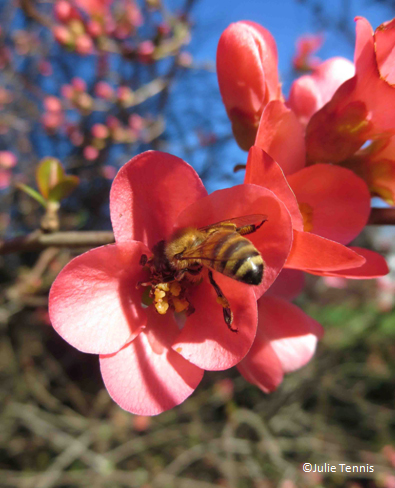 Flowering Quince (Chaenomeles speciosa) is a member of the Rose family, cultivated from plants first brought from Japan to Europe in the late 1700’s. The genus went through a few iterations before botanists finally settled on Chaenomeles (which means “split apple.”)
Flowering Quince (Chaenomeles speciosa) is a member of the Rose family, cultivated from plants first brought from Japan to Europe in the late 1700’s. The genus went through a few iterations before botanists finally settled on Chaenomeles (which means “split apple.”)
Description
With space and in full sun, the flowering quince will grow into a 10-foot high round bush with multiple stems. The salmon-pink flowers come out in early spring (February in Western Washington), weeks before the leaves begin to emerge. These plants can often be found along forest edges and in other places where nature is reclaiming old homesteads. Early spring is the best time to look for them, their bright flowers a contrast against the brown of winter.
Habitat
They are tolerant of a variety of soil conditions, from high sand content to high clay. I’ve seen them growing in old sand dunes near the ocean, and there are several in my little town where the soil rests on the clay of old seafloor sediments. They will tolerate most light conditions as well, though come into their potential in full sun.
Animal Use
Bees, flies, hummingbirds and other pollinators visit the flowers (especially good for those pollinators who are active in late winter/early spring). The shrubby bushes provide cover for a variety of songbirds.
Human Use
The fruit is edible – after cooking. Primarily used in jams and jellies. Fruit is harvested in the fall when it becomes fragrant. (I haven’t gotten to this stage yet, so I cannot attest to the flavor.)
The fruit has medicinal qualities as well, and is used in Traditional Chinese Medicine as well as in more modern herbal preparations.
References
History:
Weber, Claude. “Cultivars in the Genus Chaenomeles,” Arnoldia 23.3 (1963): 17-75. Print.
Human Use:
Schar, Douglas. “Japanese Quince,” Doctor Schar. http://doctorschar.com/features/japanese-quince-chaenomeles-japonica/ Accessed 25 March, 2015.